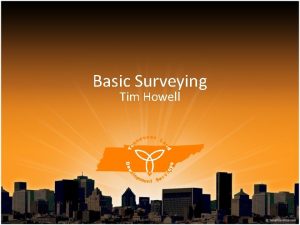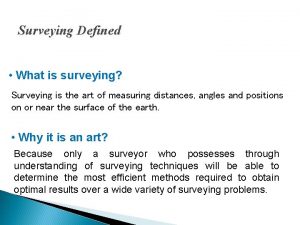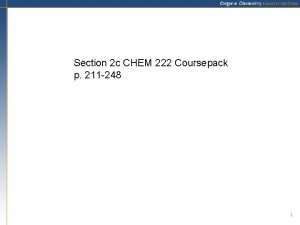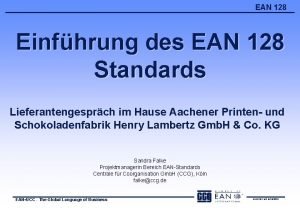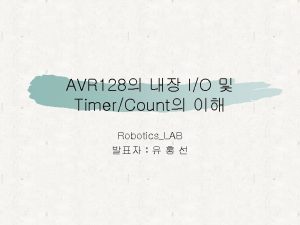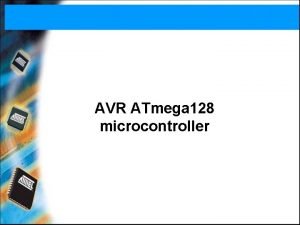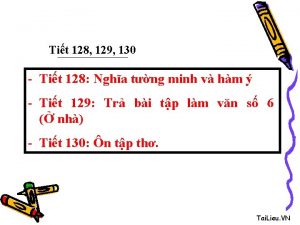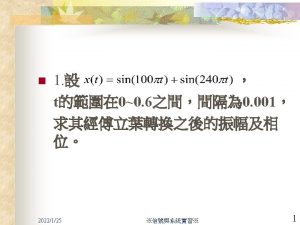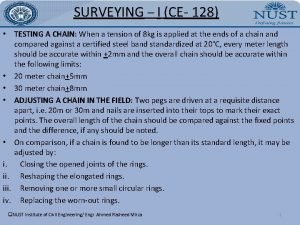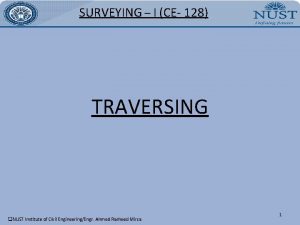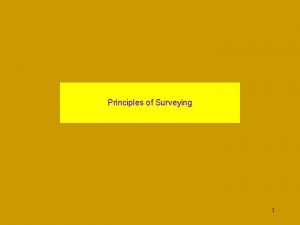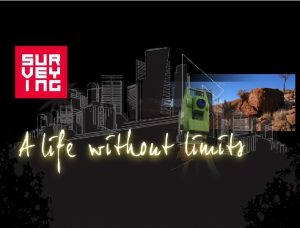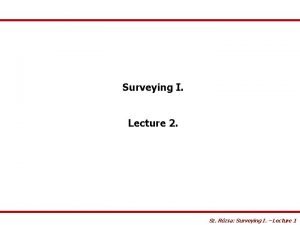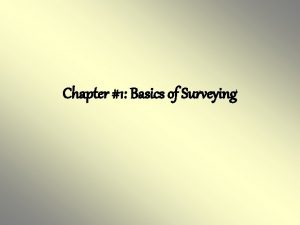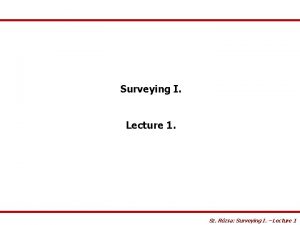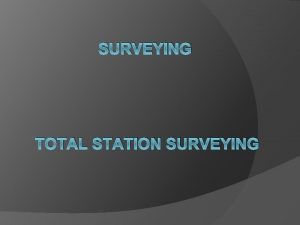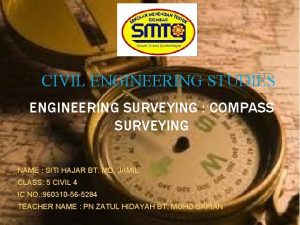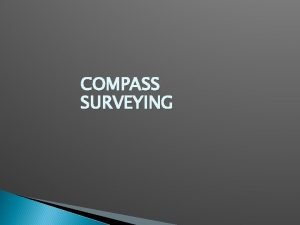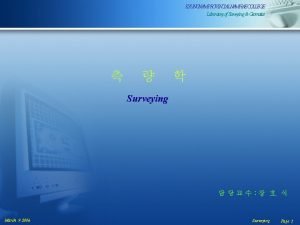SURVEYING I CE 128 COURSEPACK FOR UG q














































































- Slides: 78

SURVEYING – I (CE- 128) COURSEPACK FOR UG q. NUST Institute of Civil Engineering/Engr Muhammad Ammar 1

SURVEYING – I (CE- 128) o OBJECTIVES o COURSE OUTLINE o DETAILED SYLLABUS o LESSON PLAN q. NUST Institute of Civil Engineering/Engr Muhammad Ammar 2

SURVEYING – I (CE- 128) OBJECTIVES q. NUST Institute of Civil Engineering/Engr Muhammad Ammar 3

SURVEYING – I (CE- 128) OBJECTIVES o To enable students to understand theory and practical of surveying o To develop skills to use the modern survey instruments q. NUST Institute of Civil Engineering/Engr Muhammad Ammar 4

SURVEYING – I (CE- 128) COURSE OUTLINE q. NUST Institute of Civil Engineering/Engr Muhammad Ammar 5

SURVEYING – I (CE- 128) COURSE OUTLINE o COURSE TITLE: SURVEYING – I o COURSECODE: CE – 128 o CREDIT HRS: THEORY: PRAC: 3 2 1 o NO. OF WEEKS: 18 o INSTRUCTOR: ENGR MUHAMMAD AMMAR q. NUST Institute of Civil Engineering/Engr Muhammad Ammar 6

SURVEYING – I (CE- 128) SCHEDULE o WEEK # 01: General Introduction to Survey (Lec 1) o WEEK # 02: Distance Measurement & Chain/Compass Surveying (Lec 2) o WEEK # 03: Plane Table Surveying (Lec 3) o WEEK # 04: Traversing (Lec 4) o WEEK # 05: Traversing (Lec 5) o WEEK # 06: Traversing (Lec 6) q. NUST Institute of Civil Engineering/Engr Muhammad Ammar 7

SURVEYING – I (CE- 128) o WEEK # 07: Leveling (Lec 7) o WEEK # 08: Leveling (Lec 8) o WEEK # 09: Leveling (Lec 9) o WEEK # 10: Contouring (Lec 10) o WEEK # 11: Contouring (Lec 11) o WEEK # 12: Computation of Areas (Lec 12) o WEEK # 13: Computation of Volumes (Lec 13) q. NUST Institute of Civil Engineering/Engr Muhammad Ammar 8

SURVEYING – I (CE- 128) o WEEK # 14: Modern Instruments in Survey (Lec 14) o WEEK # 15: Modern Instruments in Survey (Lec 15) o WEEK # 16: Practical Survey Training (SURVEY WEEK) q. NUST Institute of Civil Engineering/Engr Muhammad Ammar 9

SURVEYING – I (CE- 128) DISTRIBUTION OF MARKS o THEORY 4 x Quiz 2 x Assignment 2 x One Hour Test (OHT) 1 x Final Exam 15 Marks 05 Marks 30 Marks 50 Marks o PRACTICAL* Practical Work/Projects Final (Viva) Performance in field work/attendance 60 Marks 30 Marks 10 Marks * Details will be conveyed to you before the start of survey week q. NUST Institute of Civil Engineering/Engr Muhammad Ammar 10

SURVEYING – I (CE- 128) RECOMMENDED BOOKS o Surveying Principles and Applications by Kavanagh o Surveying and Leveling Vol. 1 by Kanetkar o Surveying for Construction by Irvine (Reference Book) o Surveying Theory and Practice by Davis; Mc. Graw Hill (Reference Book) q. NUST Institute of Civil Engineering/Engr Muhammad Ammar 11

SURVEYING – I (CE- 128) DETAILED SYLLABUS q. NUST Institute of Civil Engineering/Engr Muhammad Ammar 12

SURVEYING – I (CE- 128) DETAILED SYLLABUS 1. GENERAL INTRODUCTION: Definition of survey, principle of survey, types of survey, classification of survey, instruments used in survey, precision and accuracy, accuracy ratio, scale and its construction, distance measurement and use of instrument for distance measurement, errors, distance measured by tape and errors involved, methods of chain surveying and errors involved. 2. PLANE TABLE SURVEYING: Part and accessories of plane table, setting and orientation, methods of plane tabling. 3. TRAVERSING: Methods of traversing, bearings and calculation of angles from bearings, traversing with chain and compass. q. NUST Institute of Civil Engineering/Engr Muhammad Ammar 13

SURVEYING – I (CE- 128) 4. LEVELING: Definitions, types of levels, Staff, principles of leveling, reduction of levels, profile leveling, curvature, refraction, effect of curvature and refraction, corrections, barometric leveling, hypsometry, errors in leveling. 5. CONTOURING: Definitions, characteristics & uses, locating contours, interpolation of contours, setting grade stake for sewers. 6. COMPUTATION OF AREAS: introduction, determination of areas, computation of areas from plans, trapezoidal rule, simpson rule q. NUST Institute of Civil Engineering/Engr Muhammad Ammar 14

SURVEYING – I (CE- 128) 8. COMPUTATION OF VOLUMES: measurement of volumes from crosssections and various formulas for computation of volumes, determination of capacity of reservoir. 9. MODERN METHODS IN SURVEYING: principles of EDMI, EMD characteristics, total station, Global Position System. q. NUST Institute of Civil Engineering/Engr Muhammad Ammar 15

SURVEYING – I (CE- 128) LESSON PLAN q. NUST Institute of Civil Engineering/Engr Muhammad Ammar 16

SURVEYING – I (CE- 128) LECTURE # 01: INTRODUCTION TO SURVEY 1. 2. Definition: - Surveying is the art of making such measurements as will determine the relative positions of distinctive features on the surface of the earth in order that the shape and extent of any portion of earth`s surface may be ascertained and delineated on a map or plan. It is essentially a process of determining positions of points in a horizontal plane. OR Surveying is the art and science of measuring distances, angles & positions, on or near the surface of the earth. “Leveling is art of determining the position of point in vertical plane”. Object of Survey: q The primary object of surveying is the preparation of a plan or map. q A plan is therefore, the projected representation to some scale, of the ground and the object on the horizontal plane which is represented by the plane of the paper on which the plan is drawn. The representation is called a map, if the scale is small, while it is called a plan, if the scale is large, e. g. a map of UK, a plan of a building. q The science of surveying has been developing from the very initial stage of human civilization according to his requirement. Earliest surveys were performed only for the purpose of demarcating its boundaries of plots of land. q. NUST Institute of Civil Engineering/ Engr Muhammad Ammar 17

SURVEYING – I (CE- 128) q q 3. Due to advancement in technology, the science of surveying has also attained its due importance. In the absence of accurate maps, it is impossible to lay out the alignments of roads, railways, canals, tunnels, transmission power lines, & microwave or television relaying towers. Detailed map of the sites of engineering projects are necessary, therefore, surveying is the first step in the execution of any project Types of Surveys: - q q (1) Plane Surveying and (2) Geodetic Surveying Plane surveying: In plane surveying the curvature of the earth is not taken into account, as the surveys extend over small areas. In dealing with plane surveys, the knowledge of plane geometry & trigonometry is only required. Surveys covering an area up to 260 sq. km may be treated as plane surveys because the difference in length between the arc & the subtended chord on the earth surface for a distance of 18. 2 km is only 0. 1 m. Scope & Use of Plane Surveying: Plane Surveys are carried out for engineering projects on sufficiently large scale. They are used for the layout of highways, railways, canals, fixing boundary pillars, construction of bridges etc. For majority of engineering projects, plane surveying is the first step to execute them. q. NUST Institute of Civil Engineering/ Engr Muhammad Ammar 18

SURVEYING – I (CE- 128) q q Geodetic Surveying: The surveys in which curvature of the earth is taken into account & higher degree of accuracy in linear as well as angular observations is achieved are known as Geodetic Surveying. As the surveys extend over large areas, lines connecting any two points are on the surface of the earth are treated as arcs. A knowledge of spherical trigonometry is necessary for making measurements for the geodetic surveys. Scope & Use of Geodetic Surveying: Geodetic Surveys are conducted with highest degree of accuracy to provide widely spaced control points on the earth’s surface for subsequent plane surveys. In Pakistan, Geodetic Surveys are usually carried out by the survey of Pakistan. 4. Classification Surveys may be classified in a variety of ways: a. Classification based upon the nature of the field of survey: (1) Land Surveys. (2) Hydrographic Surveys. (3) Astronomical Surveys. b. (1) (2) Classification based upon the object of survey: Archaeological Surveys for unearthing relics of antiquity Geological Surveys for determining different strata in the earth’s crust. q. NUST Institute of Civil Engineering/ Engr Muhammad Ammar 19

SURVEYING – I (CE- 128) (3) (4) (5) Mine Surveys for exploring mineral wealth such as gold, coal, etc. Military Surveys for determining points for strategic importance both offensive and defensive. Engineering Surveys for determination of quantities for designing engineering works. c. (1) (2) Classification based upon the methods employed in survey: Triangulation Surveys. Traverse Surveys. d. (1) (2) (3) (4) (5) (6) Classification based upon the instrument employed: Chain Surveys. Theodolite Surveys. Tachometric Surveys. Compass Surveys Plane Table Surveys. Photogrammetric Surveys. q. NUST Institute of Civil Engineering/ Engr Muhammad Ammar 20

SURVEYING – I (CE- 128) q. NUST Institute of Civil Engineering/ Engr Muhammad Ammar 21

SURVEYING – I (CE- 128) q. NUST Institute of Civil Engineering/ Engr Muhammad Ammar 22

SURVEYING – I (CE- 128) q. NUST Institute of Civil Engineering/ Engr Muhammad Ammar 23

SURVEYING – I (CE- 128) q. NUST Institute of Civil Engineering/ Engr Muhammad Ammar 24

SURVEYING – I (CE- 128) q. NUST Institute of Civil Engineering/ Engr Muhammad Ammar 25

SURVEYING – I (CE- 128) 6. Land surveys may be further sub-divided into the following classes: (a) Topographical Surveys for determining the natural features of a country such as hills, valleys. Rivers, nallas, takes, woods, towns, villages etc. (b) Cadastral surveys in which additional details such as boundaries of fields, houses and other properties, path ways, are determined. (c) City Surveys for laying out plots and constructing streets, water supply systems, and sewers. 7. Engineering Surveys may be further sub-divided into: (i) Reconnaissance surveys for determining the feasibility and rough cost of the scheme. (ii) Preliminary surveys for collecting more precise data to choose the best location for the work and to estimate the exact quantities and costs (iii) Location surveys for setting out the work on the ground. 8. Principles of Surveying: various survey methods are based are: q. NUST Institute of Civil Engineering/ Engr Muhammad Ammar The two fundamental principles upon which 26

SURVEYING – I (CE- 128) 1. To work from the whole to the part: The main principle of surveying is to work from the whole to the part. To achieve this in actual practice, a sufficient number of primary control points are established with higher precision in & around the area to be detail surveyed. Minor control points in between the primary control points are then established with less precise method. Further details are surveyed with the help of these minor control points by adopting any one of the survey methods. The main idea of working from the whole to the part is to prevent accumulation of error & to localize minor errors within the framework of the control points. On the other hand, if survey is carried from the part to the whole, the errors would expand to greater magnitudes & the scale of the survey will be distorted beyond control. 2. Location of a point by measurement from two control points: The control points are selected in the area & the distance between them is measured accurately. The line is then plotted to a convenient scale on a drawing sheet. The location of the required point may then be plotted by making two measurements from the given control points as follow: Let A & B be two given control points. Any other point, say D can be located with reference to these points, by any one of the following method: q. NUST Institute of Civil Engineering/ Engr Muhammad Ammar 27

SURVEYING – I (CE- 128) • Rectangular coordinates by the perpendicular d. D and the distance Ad. The distance Bd may be measured instead of Ad (fig--) • Trilateration: by the two distances AD and BD (fig--) • Polar coordinates: the angle BAD measured at A and the distance AD. Instead, by angle DBA measured at B and the distance BD (fig--) • Triangulation: by the two angles BAD and ABD measured at A and B (fig---) q. NUST Institute of Civil Engineering/ Engr Muhammad Ammar 28

SURVEYING – I (CE- 128) 9. Scales: - The scale of a map or plan is the fixed proportion which every distance between the locations of the points on the map or plan bears to the corresponding distance between their positions on the ground. Thus if 1 cm on the map represents 10 m on the ground, the scale of the map is 10 m to 1 cm often written simply as 1 cm = 10 m. The scale is also expressed by means of a regular fraction whose numerator is invariably unity. The fraction is called “Representative Fraction (R. F)”. For example, if the scale is 10 m to 1 cm, the R. F. of the scale is 1 cm / [10 × 100 cm] = 1/1000 Scales of the maps are represented by the following two methods: a). NUMERICAL SCALES b). GRAPHICAL SCALES Characteristics of a Scale Line: a. It should be sufficiently long. (Usually between 18 cm to 27 cm but not more than 32 cm) b. It should be accurately divided and carefully numbered. c. The zero must always be placed between the unit and its subdivisions. d. The name of the scale together with its representative fraction should be written on the plan. e. It should be easily read and should not involve any arithmetic calculation in measuring distance on the map. The main divisions should, therefore, represent one, ten, or hundred units. q. NUST Institute of Civil Engineering/ Engr Muhammad Ammar 29

SURVEYING – I (CE- 128) q. NUST Institute of Civil Engineering/ Engr Muhammad Ammar 30

SURVEYING – I (CE- 128) q. NUST Institute of Civil Engineering/ Engr Muhammad Ammar 31

SURVEYING – I (CE- 128) Plain Scale: On a plain scale it is possible to read only two dimensions such as meters and decimeters, units and tenths etc. Example: Draw a scale 1 cm = 4 m to read to a meter and show on it 47 m. Const: Draw a line 20 cm long and divide it into eight equal parts. Subdivide the first division from the left into 10 equal parts each subdivision reading 1 meter. Place the zero between the subdivided part and the undivided part and mark the figures counting from zero in both dir. To read 47 m place one leg of the dividers at 40 and the other at 7. 10. Stages of Survey Operations: The entire work of a survey operation may be divided into three distinct stages: 1. Field work-Reconnaissance, Observations, Field Records 2. Office work-Drafting, Computing, Designing 3. Care & adjustment of the instruments 11. Accuracy Of Surveyed Quantities: q Surveyors’ primary objective is to achieve accuracy in their measurements. q Survey is of little value if it is not accurate. q In surveying, the most common task is to find the 3 D positions of a series of q. NUST Institute of Civil Engineering/ Engr Muhammad Ammar 32

SURVEYING – I (CE- 128) q. NUST Institute of Civil Engineering/ Engr Muhammad Ammar 33

SURVEYING – I (CE- 128) q. NUST Institute of Civil Engineering/ Engr Muhammad Ammar 34

SURVEYING – I (CE- 128) q. NUST Institute of Civil Engineering/ Engr Muhammad Ammar 35

SURVEYING – I (CE- 128) points, the x, y & z coordinates. Physical measurements are therefore required in the form of linear, angular & height dimensions. There will be error in these quantities which must be eliminated, discounted or distributed. a). Classification of Errors: Gross: They are simply mistakes. They arise mainly due to the inexperience, ignorance or carelessness of the surveyor. These errors cannot be accommodated & observations have to be repeated. Examples: reading the tape wrongly, recording a wrong dimension when booking, turning the wrong screw on an instrument. Systematic: These are errors which arise unavoidably in surveying & follow some fixed law. Their sources are well known. A simple example is illustrated by the temp error in tape measurements. A tape is only correct at a certain standard temp; therefore if the ambient temp on a certain day is higher or lower than standard, the tape will expand or contract & cause an error which will be the same no matter how often the line is measured. q. NUST Institute of Civil Engineering/ Engr Muhammad Ammar 36

SURVEYING – I (CE- 128) Constant: These are errors which do not vary at any time, in other words, they have the same sign, either positive or negative. As an illustration, consider the nature of the dimensions required for plotting on maps & plans. These must be horizontal & if no attention is paid to the slope of the ground when making a measurement, the dimension so obtained will be too long. No matter how often the measurement is made or how many other slopes are measured, the results will always be too long. Likewise, if a tape has stretched through continuous use, any resultant measurements will always be too short. Constant errors are well known & appropriate corrections are applied to obtain the correct result. Accidental/Random: These are the small errors which inevitably remain after the others have been eliminated. There are three main causes: Imperfections of human sight & touch (human errors), Imperfections of the instruments being used at the time & Changing atmospheric conditions. A good example arises in the measurement of an angle using an instrument called a theodolite. q. NUST Institute of Civil Engineering/ Engr Muhammad Ammar 37

SURVEYING – I (CE- 128) b). Accuracy & Precision: Accuracy & Precision are not synonymous. The difference is illustrated in the following example: A line of survey is measured six times & all six measurements lie within an error band of ± 2 mm. However, the tape when checked, is found to have stretched by 10 mm through continuous use. The results of the six measurements are precise in that they have little scatter but they are not accurate because each is in error by 10 mm. In surveying, accuracy is defined by specifying the limits between which the error of a measured quantity may lie, for example, the accuracy of the measured building might be (20. 54 ± 0. 01) metres. Accuracy Ratio: The accuracy ratio of a measurement or series of measurements is the ratio of error of closure to the distance measured. The error of closure is the difference between the measured location & theoretically correct location. To illustrate, a distance was measured & found to be 250. 56 ft. The distance was previously known to be 250. 50 ft. The error is 0. 06 ft in a distance of 250. 50 ft. q. NUST Institute of Civil Engineering/ Engr Muhammad Ammar 38

SURVEYING – I (CE- 128) q. NUST Institute of Civil Engineering/ Engr Muhammad Ammar 39

SURVEYING – I (CE- 128) accuracy ratio = 0. 06/250. 50 = 1/4175 = 1/4200 The accuracy ratio is expressed as a fraction whose numerator is unity & whose denominator is rounded to the closest 100 units. q. NUST Institute of Civil Engineering/ Engr Muhammad Ammar 40

SURVEYING – I (CE- 128) LECTURE: DISTANCE MEASUREMENT q Two main methods of determining the distances between points on the surface of the earth. q Direct Measurement: distances are actually measured on the surface of the earth by means of chains, tapes etc. q Computative Measurement: Distances are determined by calculations indirectly by using the field data as in triangulation, tacheometry etc. q Instruments for Measuring Distances: 1). Chain-Gunter’s Chain (66 ft), Engineer’s Chain(100 ft), Metric Chain(20/30 m) 2). Steel Band 3). Tapes-Cloth/Linen Tape, Metallic Tape, Steel Tape, Invar Tape q Arrows/Chain Pins: 10 arrows generally accompany a chain, used to mark the end of each chain during the process of chaining. q. NUST Institute of Civil Engineering/ Engr Muhammad Ammar 41

SURVEYING – I (CE- 128) q. NUST Institute of Civil Engineering/ Engr Muhammad Ammar 42

SURVEYING – I (CE- 128) q. NUST Institute of Civil Engineering/ Engr Muhammad Ammar 43

SURVEYING – I (CE- 128) q Instruments for Marking Stations: 1). Pegs 3). Ranging Poles 2). Ranging Rods 4). Offset Rod 5). Plumb Bobs q Ranging a Line: The process of marking a number of intermediate points on a survey line joining two stations in the field so that the length between them may be measured correctly, is known as ranging. Ranging may be classified as DIRECT RANGING & INDIRECT RANGING q Direct Ranging: When intermediate ranging rods are placed along the chain line, by direct observation from either end station, the process is known as direct ranging. q Line Ranger: It is a small reflecting instrument used for fixing intermediate points on a chain line. q Indirect Ranging: When end stations are not intervisible & the intermediate ranging rods are placed in line by interpolation or by reciprocal ranging or by running an auxiliary line (or random line), the process is known as Indirect Ranging. q. NUST Institute of Civil Engineering/ Engr Muhammad Ammar 44

SURVEYING – I (CE- 128) q. NUST Institute of Civil Engineering/ Engr Muhammad Ammar 45

SURVEYING – I (CE- 128) q. NUST Institute of Civil Engineering/ Engr Muhammad Ammar 46

SURVEYING – I (CE- 128) q Degree of Accuracy in Chaining: For comparison of precision of chaining when line of different lengths are measured under dissimilar conditions, it is the usual practice to express the error as ratio (1: n), which is called the chaining ratio. It is the ratio of the error to the distance measured. EXAMPLE: 1/1500, 1/5000 etc. By this is meant an error of 1 unit in 1500 units, or an error of 1 unit in 5000 units The limits of errors under different conditions are as follows: 1). For ordinary measurements with a steel band on flat ground & with careful work: 1 in 2000. 2). For ordinary measurements with a carefully tested chain on fairly level ground & with reasonable care: 1 in 1000. 3). Under average conditions: 1 in 500. 4). For measurements over rough or somewhat hilly ground: 1 in 250. q Error in Measurement due to Incorrect Chain Length: “If the chain is too long, the measured distance will be less & if the chain is too short, the measured distance will be more. ” a. The true length of line = L´ / L x measured length of line Where L´ = the incorrect length of a chain or tape And L = the true length of a chain or tape Note : Use plus sign when the chain is too long and minus sign when it is too short q. NUST Institute of Civil Engineering/ Engr Muhammad Ammar 47

SURVEYING – I (CE- 128) b. The true area of a plot of a land = (L´/L)2 x Measured area of the plot c. The true volume of an excavation = (L´/L)3 x Measured volume of the excavation q Examples on Correction of Distance and Area: 1. The length of a line measured with a 20 m chain was found to be 634. 4 m. It was afterwards found that the chain was 0. 05 m too long. Find the true length of the line. Solution: True length of line = L’/L x measured length of line. L’ = 20. 05 m. L = 20 m. Measured length = 634. 4 m. Therefore, True length of the line = 20. 05/20 x 634. 4 = 635. 586 m = 635. 5 m (approx) q. NUST Institute of Civil Engineering/ Engr Muhammad Ammar 48

SURVEYING – I (CE- 128) 2. The length of a line measured by means of a 20 m chain was found to be 610. 2 m known to be 612. 0 m. What was the actual length of the chain? Solution: Since the measured length of the line is less than its true length, the chain was too long. Now true length of the line = L’/L x measured length. True length of the line = 612. 0 m. Measured length of the line = 610. 2 m. L = 20. 0 m. : . 612. 0 = L’/20. 0 x 610. 2 : . L’ = 612. 0 x 20. 0/610. 2=20. 066 m. 3. A 20 m chain was found to be 0. 05 m too long after chaining 1400 m. It was found to be 0. 1 m too long after chaining 2200 m. If the chain was correct before commencement of the work find the true distance. Solution: a. Since the chain was correct i. e. 20 m long at the beginning and was 20. 05 m long after chaining 1400 m, the increase in length was gradual. : . Mean elongation = 0+0. 05/2=0. 025 m. : . True distance = 20. 025/20 x 1400 = 1401. 75 m. q. NUST Institute of Civil Engineering/ Engr Muhammad Ammar 49

SURVEYING – I (CE- 128) b. The remaining distance (2200 -1400) = 800 m was measured with the same chain. If was 0. 05 m too long at the commencement of chaining and 0. 10 m too long at the end of chaining. : . Mean elongation = 0. 05+0. 10/2 = 0. 075 m. True distance = 20. 075/20 x 800 = 803. 00 m. where, total true distance = 1401. 75 + 803. 00 m. = 2204. 75 m. q CHAINING ON SLOPING GROUNDS: 1). Chaining on the surface of a sloping ground gives the sloping distance. 2). For plotting the surveys, horizontal distances are required. 3). It is therefore, necessary either to reduce the sloping distances to horizontal equivalents or to measure the horizontal distances between the stations directly. 4). Two methods for getting the horizontal distance between two stations on a sloping ground: DIRECT METHOD & INDIRECT METHOD q. NUST Institute of Civil Engineering/ Engr Muhammad Ammar 50

SURVEYING – I (CE- 128) Fig. DIRECT METHOD: Horizontal distances are measured on the ground in short horizontal lengths. Also known as ‘Stepping Method’. q. NUST Institute of Civil Engineering/ Engr Muhammad Ammar 51

SURVEYING – I (CE- 128) Fig. INDIRECT METHOD: Measuring the slope angle with a CLINOMETER Fig. INDIRECT METHOD: Measuring the slope angle from Difference in Elevations q. NUST Institute of Civil Engineering/ Engr Muhammad Ammar 52

SURVEYING – I (CE- 128) Fig. INDIRECT METHOD: Hypotenusal Allowance Correction Method q. NUST Institute of Civil Engineering/ Engr Muhammad Ammar 53

SURVEYING – I (CE- 128) q ERRORS IN CHAINING: 1). Cumulative Errors 2). Compensative Errors o CUMULATIVE ERRORS: The errors which occur in the same direction & tend to accumulate, or to add up are called Cumulative Errors. Such errors make the apparent measurements always either too long or too short. a). Positive Cumulative Errors: Those errors which make the measured lengths more than the actuals are known as positive cumulative errors. These are caused in the following situations: i). The length of the chain or tape is shorter than its standard length. ii). The slope correction ignored while measuring along the sloping ground. iii). The sag correction, if not applied, when the chain or tape is suspended at its ends. iv). Due to incorrect alignment. v). Due to working in windy weather. q. NUST Institute of Civil Engineering/ Engr Muhammad Ammar 54

SURVEYING – I (CE- 128) b). Negative Cumulative Errors: The errors which make the measured lengths less than the actuals are known as negative cumulative errors. These are caused in the following situations: i). The length of the chain or tape is greater than its standard length. o COMPENSATING ERRORS: The errors which are liable to occur in either direction & tend to compensate are called compensating errors. These are caused in the following situations: i). Incorrect holding of the chain ii). The chain is not uniformly calibrated throughout its length iii). Refinement is not made in plumbing during stepping method q COMMON MISTAKES IN CHAINING: i). Displacement of the arrows ii). Failure to observe the zero point of the tape iii). Adding or omitting a full chain length iv). Reading from the wrong end of the chain v). Reading numbers wrongly/ Reading wrong meter marks vi). Wrong recording in the field book viii). Calling numbers wrongly q. NUST Institute of Civil Engineering/ Engr Muhammad Ammar 55

SURVEYING – I (CE- 128) q CORRECTIONS FOR LINEAR MEASUREMENTS: i). Correction for Standard Length ii). Correction for Alignment iii). Correction for Slope iv). Correction for Temperature v). Correction for Tension vi). Correction for Sag q CORRECTION FOR STANDARD LENGTH: where: Ca = L. C/ l Ca = Correction for absolute length L = Measured length of a line l = nominal or designated length of the tape C = Correction to be applied to the tape q. NUST Institute of Civil Engineering/ Engr Muhammad Ammar 56

SURVEYING – I (CE- 128) q CORRECTION FOR ALIGNMENT: 1). When the two stations are visible: The Required Correction = l 1(1 - cos θ 1) + l 2(1 - cos θ 2) 2). When the two stations are not visible: AB = √ [AC 2 + BC 2 – 2 AC. BC. cosφ] q CORRECTION FOR SLOPE: 1). CASE 1: Let L = slope distance D = horizontal distance h = difference in elevations of A & B Therefore, D = √(L 2 – h 2) and Slope Correction = L – D = h 2/2 L 2). CASE 2: Slope Correction = L – L cosφ = L (1 – cosφ) q. NUST Institute of Civil Engineering/ Engr Muhammad Ammar 57

SURVEYING – I (CE- 128) q CORRECTION FOR TEMPERATURE: Correction for Temperature is given by the formula: Ct = α L (Tm – To) where: Ct = correction for temperature α = coefficient of thermal expansion Tm = mean temperature during measurement To = temperature at which the tape is standardized L = measured length q CORRECTION FOR PULL (TENSION): Correction for Pull is given by the formula: where: Cp = (Pm – Po) × L / AE Cp = correction for pull Pm = pull applied during measurement Po = pull under which the tape is standardized A = cross-sectional area of the tape E = modulus of elasticity of steel L = measured length q. NUST Institute of Civil Engineering/ Engr Muhammad Ammar 58

SURVEYING – I (CE- 128) q. CORRECTION FOR SAG: Correction for Sag is given by the formula: where: Cs = l 1 (Mg)2 / 24 P 2 Cs = correction for sag M = total mass of the tape P = applied pull l 1 = distance between supports q EXAMPLES ON CORRECTIONS: 1). A line was measured with a steel tape which was exactly 30 m long at 18°C & found to be 452. 343 m. The temperature during measurement was 32°C. Find the true length of the line. Take coefficient of expansion of the tape per °C = 0. 0000117. Solution: Here, l = 30 m, To = 18°C, Tm = 32°C, α = 0. 0000117 Ct / unit length = 0. 004914 m (+ive) length of the tape at 32°C = 30. 004914 m Now, True length = 30. 004914/30 × 452. 343 = 452. 417 m q. NUST Institute of Civil Engineering/ Engr Muhammad Ammar 59

SURVEYING – I (CE- 128) 2). A line was measured with a steel tape which was exactly 30 m at 18°C & a pull of 50 N & the measured length was 459. 242 m. Temperature during measurement was 28°C & the pull applied was 100 N. The tape was uniformly supported during the measurement. Find the true length of the line if the cross-sectional area of the tape was 0. 02 cm 2, the coefficient of expansion per °C = 0. 0000117 & the modulus of elasticity = 21 × 10 6 N/cm 2. Solution: Here, l = 30 m, To = 18°C, Tm = 28°C, α = 0. 0000117 Pm = 100 N, Po = 50 N, A = 0. 02 cm 2, E = 21 × 106 N/cm 2 correction per tape length = 0. 0000117 × (28 -18) × 30 Ct / unit length = 0. 00351 m (+ive) pull correction per tape length = (100 - 50) × 30/(0. 02 × 21 × 106) Cp / unit length = 0. 00357 (+ive) Therefore, combined correction = 0. 00708 m True length of tape = 30. 00708 m True length of the line = 459. 242 m q. NUST Institute of Civil Engineering/ Engr Muhammad Ammar 60

SURVEYING – I (CE- 128) 3). A 50 m tape is suspended between the ends under a pull of 150 N. The mass of the tape is 1. 52 kilograms. Find the corrected length of the tape. Solution: Here, l 1 = 50 m, M = 1. 52 kg, P = 150 N Correction for sag = Cs = 50 × (1. 52 × 9. 81)2 / (24 × 1502) = 0. 0206 m Corrected length of the tape = 50 – 0. 0206 = 49. 9794 m. q. NUST Institute of Civil Engineering/ Engr Muhammad Ammar 61

SURVEYING – I (CE- 128) ASSIGNMENT # 01 (DATE OF SUBMISSION: 21 ST Oct, 2009) 1). A base line AC was measured in two parts along two straight drains AB & BC of length 1650 m & 1819. 5 m with a steel tape which was exactly 30 m at 25°C at a pull of 10 kg. The applied pull during measurement of both parts was 20 kg whereas respective temperatures were 45°C & 40°C. The slopes of drains AB & BC were 3° & 3° 30ʹ & the deflection angle of BC was 10° right. Find the correct length of the base line if the cross sectional area of the tape was 0. 025 sq. cm. The coefficient of expansion & modulus of elasticity of tape material were 3. 5 × 10 -6 per °C & 2. 1 × 106 kg/cm 2. 2). A survey line AB is running along different slopes. There is a downward slope of 1 in 10 from station A to chainage 238 m. The ground has an angle of elevation of 8° 15ʹ from chainage 238 m to chainage 465 m. There is a rise of 25 m from chainage 465 m to station B having chainage of 665 m. All the measurements of chainages have actually been taken along the ground. It was found that the 20 m chain used for chaining was 5 cm too long throughout the work. Calculate the correct horizontal distances from station A to station B in the case. q. NUST Institute of Civil Engineering/ Engr Muhammad Ammar 62

SURVEYING – I (CE- 128) LECTURE : CHAIN SURVEYING q CHAIN TRIANGULATION OR CHAIN SURVEYING: It is the system of surveying in which the sides of the various triangles are measured directly in the field and no angular measurements are taken. It is most suitable when: (i). The ground is fairly level and open with simple detail. (ii). Plans are required on a large scale such as those of estates, fields, etc. (iii). The area is small in extent. It is unsuitable for large areas, and areas crowded with many details, or difficult or wooded countries. q PRINCIPLE OF CHAIN SURVEYING: The principle of a chain survey is triangulation. It consists of the arrangement of framework of triangles, since a triangle is the only simple plane figure, which can be plotted from the lengths of its sides alone. The framework should therefore, consist of triangles which are as nearly equilateral as possible, such triangles being known as well conditioned, or well shaped. A triangle is said to be well conditioned or well proportioned when it contains no angle smaller than 30 o and no angle greater than 120 o. Illconditioned triangles having angles less than 30 o or greater than 120 o should always be avoided. If however, they are unavoidable, great care must be taken in chaining and plotting. q. NUST Institute of Civil Engineering/ Engr Muhammad Ammar 63

SURVEYING – I (CE- 128) q TECHNICAL TERMS & THEIR DEFINITIONS: 1). Main Survey Station: The point where two sides of a main triangle meet is called main survey station. Main survey station is a point of importance at the beginning & at the end of a chain line. 2). Subsidiary Survey Station (or Tie Station): The stations which are selected on the main survey lines for running auxiliary lines are called subsidiary stations. 3). Main Survey Lines: The chain lines joining the main survey stations are known as main survey lines. 4). Auxiliary, Subsidiary, or Tie Lines: The chain lines joining the subsidiary survey stations are known as auxiliary, subsidiary or more commonly as tie lines. These are provided to locate the interior details which are far away from the main lines. 5). Base Line: The longest of the main survey lines is called a base line. Various stations are plotted with reference to the base line. 6). Check Line: The lines which are run in the field to check the accuracy of the field work are called check lines. If the measured length of a check line agrees with the length scaled off the plan, the survey is accurate. q. NUST Institute of Civil Engineering/ Engr Muhammad Ammar 64

SURVEYING – I (CE- 128) q. NUST Institute of Civil Engineering/ Engr Muhammad Ammar 65

SURVEYING – I (CE- 128) q FIGURE: LAYOUT OF A CHAIN SURVEY: 1. Base Line; AC 2. Main Surveying Lines: AB, BC, CD & AD 3. Subsidiary or Tie lines: BE & FD 4. Check Lines: HG & MN 5. Main Surveying Stations: A, B, C & D 6. Subsidiary Stations: E & F q. NUST Institute of Civil Engineering/ Engr Muhammad Ammar 66

SURVEYING – I (CE- 128) q SELECTION OF STATIONS: The following points should be kept in mind while selecting survey stations: 1). Main survey stations at the ends of chain lines should be intervisible. 2). Survey lines should be minimum possible. 3). The main principle of surveying viz. , working from the whole to the part & not from the part to the whole, should be strictly observed. 4). Survey stations should form well conditioned triangles. 5). Every triangle should be provided with a check line. 6). Tie lines should be provided to off long offsets. 7). Obstacles to ranging & chaining, if any, should be avoided. 8). The larger side of the triangle should be placed parallel to boundaries, roads, buildings etc. to have short offsets. 9). To avoid trespassing, main survey lines should remain within the boundaries of the property to be surveyed. 10). Chain lines should be preferably over level ground. 11). Lines should be laid on one side of the road to avoid interruption of changing by passing traffic. q. NUST Institute of Civil Engineering/ Engr Muhammad Ammar 67

SURVEYING – I (CE- 128) q SELECTION & MEASUREMENT OF THE BASE LINE: In chain surveying, the base line is the most important line as it fixes the directions of all other chain lines. The following points are kept in view during its selection & measurement: 1). It should be laid preferably on a level ground. 2). It should be run through the centre of the length of the area. 3). It should be correctly measured horizontally. 4). It should be measured twice or thrice & the mean distance accepted, as its correct length. 5). Great care should be taken, to ensure straightness of the base line. 6). If convenient, two base lines perpendicular bisecting each other should be laid out. q OFFSETS: In chain surveying, the position of details i. e. boundaries, culverts, roads, stream bends etc. , are located with respect to the chain line by measuring their distances right or left of the chain lines, such lateral measurements are called offsets. There are two types of offsets: Perpendicular Offsets & Oblique Offsets Depending upon the length, offsets are further classified as short offset (length less than 15 m) & long offsets (length more than 15 m). q. NUST Institute of Civil Engineering/ Engr Muhammad Ammar 68

SURVEYING – I (CE- 128) q. NUST Institute of Civil Engineering/ Engr Muhammad Ammar 69

SURVEYING – I (CE- 128) q. NUST Institute of Civil Engineering/ Engr Muhammad Ammar 70

SURVEYING – I (CE- 128) q. NUST Institute of Civil Engineering/ Engr Muhammad Ammar 71

SURVEYING – I (CE- 128) q TAKING OFFSETS: Offset measurements are taken & noted in the field & the complete operation is known as ‘taking offsets’. Offset is taken as follows in the absence of any instrument: The leader holds the zero end of the tape at the point P for which offset is taken & the follower swings off the chain in a short arc about the point P as a centre. He finds the minimum reading, which gives the position of the foot of the perpendicular from P to AB. Such an offset is called a ‘swing offset’. The follower then fixes an arrow at the point so found & reads the chainage & the length of the offset. The surveyor, after checking, records the readings in a field book. q. NUST Institute of Civil Engineering/ Engr Muhammad Ammar 72

SURVEYING – I (CE- 128) q INSTRUMENTS FOR SETTING OUT RIGHT ANGLES: 1). Cross Staffs 2). Optical Squares q FIELD BOOK: The book in which chainages, offset measurements & sketches of detail points are recorded is generally called a field book. It is an oblong book of size 20 cm × 12 cm & opens lengthwise. 1). BOOKING FIELD NOTES: In a field book, field notes are entered from the bottom of the page upward. At the beginning of a chain line, the following information is recorded in the field book: * The name or number of the chain line * The name or number of the survey station * The symbol denoting the station mark * The direction of survey lines starting off from or ending at the station * The initial chainage which is generally zero, is enclosed in the symbol. All distances along the chain line i. e. chainages are entered on the central line or in the central column & offsets are written opposite to them on the right or left of the column according to their ground positions with respect to the chain line. Close to the q. NUST Institute of Civil Engineering/ Engr Muhammad Ammar 73

SURVEYING – I (CE- 128) offsets, their sketches are drawn to guide the draftsman to draw them correctly. Tie or subsidiary stations along a chain line should be indicated by a circleor an oval around their chainages. A specimen field book for chain survey is shown in the next slide: q. NUST Institute of Civil Engineering/ Engr Muhammad Ammar 74

SURVEYING – I (CE- 128) q. NUST Institute of Civil Engineering/ Engr Muhammad Ammar 75

SURVEYING – I (CE- 128) 2). INSTRUCTIONS FOR BOOKING THE FIELD NOTES: § Each chain line or a tie line, should be recorded on a separate page. § The recorder should always face the direction of chaining while booking the field notes. § All the measurements should be recorded as soon as these are taken & nothing should be left to memory. § The notes should be complete, neat & accurate with all information necessary for plotting the survey by a draftsman in office. § Numerals should be neatly & legibly written without any overwriting. § Sketches of the details should be neat & clear. § A good quality pencil should be used for recording the entries. § The field book is an important document & should be kept clean. Wrong entries should be scored out & correct ones written over the wrong ones. If an entire page is to be discarded, it should be crossed, & marked “cancelled”. A reference to the page on which correct readings are recorded, is made on this page. § The complete record of the chain survey should include: - A general layout plan of the lines - The details of the lines - The date of the survey - A page index of the lines - Names of the surveyor & his assistants q. NUST Institute of Civil Engineering/ Engr Muhammad Ammar 76

SURVEYING – I (CE- 128) q FIELD WORK: - Reconnaissance - Marking Stations - Running Survey Lines - REFERENCE SKETCH: The sketch, showing at least measurements to three permanent & definite points such as gates, pillars, light posts, corner of buildings etc. , is known as a reference or location sketch. q. NUST Institute of Civil Engineering/ Engr Muhammad Ammar 77

SURVEYING – I (CE- 128) q. NUST Institute of Civil Engineering/ Engr Muhammad Ammar 78
 Harvard publishing coursepack
Harvard publishing coursepack Harvard business educators
Harvard business educators Publik sektor
Publik sektor Rimma meningar
Rimma meningar Etik och ledarskap etisk kod för chefer
Etik och ledarskap etisk kod för chefer Kvinnlig mantel i antikens rom
Kvinnlig mantel i antikens rom Orubbliga rättigheter
Orubbliga rättigheter Bamse för de yngsta
Bamse för de yngsta Densitet vatten
Densitet vatten Ministerstyre för och nackdelar
Ministerstyre för och nackdelar Sju principer för tillitsbaserad styrning
Sju principer för tillitsbaserad styrning Plats för toran ark
Plats för toran ark Nationell inriktning för artificiell intelligens
Nationell inriktning för artificiell intelligens Nyckelkompetenser för livslångt lärande
Nyckelkompetenser för livslångt lärande Sju för caesar
Sju för caesar Informationskartläggning
Informationskartläggning Handledning reflektionsmodellen
Handledning reflektionsmodellen Matematisk modellering eksempel
Matematisk modellering eksempel Cks
Cks Personalliggare bygg undantag
Personalliggare bygg undantag Verktyg för automatisering av utbetalningar
Verktyg för automatisering av utbetalningar Vishnuismen
Vishnuismen Lyckans minut erik lindorm analys
Lyckans minut erik lindorm analys Inköpsprocessen steg för steg
Inköpsprocessen steg för steg Kolopskopi
Kolopskopi Strategi för svensk viltförvaltning
Strategi för svensk viltförvaltning Varians formel
Varians formel Tack för att ni har lyssnat
Tack för att ni har lyssnat Datorkunskap för nybörjare
Datorkunskap för nybörjare Ekologiskt fotavtryck
Ekologiskt fotavtryck Läkarutlåtande för livränta
Läkarutlåtande för livränta Klassificeringsstruktur för kommunala verksamheter
Klassificeringsstruktur för kommunala verksamheter Tack för att ni lyssnade
Tack för att ni lyssnade Påbyggnader för flakfordon
Påbyggnader för flakfordon Egg för emanuel
Egg för emanuel Atmosfr
Atmosfr Lågenergihus nyproduktion
Lågenergihus nyproduktion Personlig tidbok fylla i
Personlig tidbok fylla i Rutin för avvikelsehantering
Rutin för avvikelsehantering Var finns arvsanlagen
Var finns arvsanlagen Presentera för publik crossboss
Presentera för publik crossboss Fuktmätningar i betong enlig rbk
Fuktmätningar i betong enlig rbk Kontinuitetshantering
Kontinuitetshantering Myndigheten för delaktighet
Myndigheten för delaktighet Kung dog 1611
Kung dog 1611 Tack för att ni har lyssnat
Tack för att ni har lyssnat Tobinskatten för och nackdelar
Tobinskatten för och nackdelar Boverket ka
Boverket ka Referat mall
Referat mall Varför kallas perioden 1918-1939 för mellankrigstiden?
Varför kallas perioden 1918-1939 för mellankrigstiden? Karttecken höjdkurva
Karttecken höjdkurva Epiteltyper
Epiteltyper Uppställning multiplikation
Uppställning multiplikation Tryck formel
Tryck formel Elektronik för barn
Elektronik för barn Borra hål för knoppar
Borra hål för knoppar Bris för vuxna
Bris för vuxna Mat för unga idrottare
Mat för unga idrottare A gastrica
A gastrica Smärtskolan kunskap för livet
Smärtskolan kunskap för livet Trög för kemist
Trög för kemist Teckenspråk minoritetsspråk argument
Teckenspråk minoritetsspråk argument Novell typiska drag
Novell typiska drag För och nackdelar med firo
För och nackdelar med firo Ellika andolf
Ellika andolf Steg för steg rita
Steg för steg rita Toppslätskivling effekt
Toppslätskivling effekt Mall debattartikel
Mall debattartikel Redogör för vad psykologi är
Redogör för vad psykologi är En lathund för arbete med kontinuitetshantering
En lathund för arbete med kontinuitetshantering Skapa med geometriska former
Skapa med geometriska former Bästa kameran för astrofoto
Bästa kameran för astrofoto True and false calculator
True and false calculator Received bank statement showing service charge
Received bank statement showing service charge![Chars = [0] * 128 Chars = [0] * 128](data:image/svg+xml,%3Csvg%20xmlns=%22http://www.w3.org/2000/svg%22%20viewBox=%220%200%20200%20200%22%3E%3C/svg%3E) Chars = [0] * 128
Chars = [0] * 128 Trp 128
Trp 128![Chars = [0] * 128 Chars = [0] * 128](data:image/svg+xml,%3Csvg%20xmlns=%22http://www.w3.org/2000/svg%22%20viewBox=%220%200%20200%20200%22%3E%3C/svg%3E) Chars = [0] * 128
Chars = [0] * 128 128 şüpheli ticari alacaklar
128 şüpheli ticari alacaklar![Chars = [0] * 128 Chars = [0] * 128](data:image/svg+xml,%3Csvg%20xmlns=%22http://www.w3.org/2000/svg%22%20viewBox=%220%200%20200%20200%22%3E%3C/svg%3E) Chars = [0] * 128
Chars = [0] * 128








































































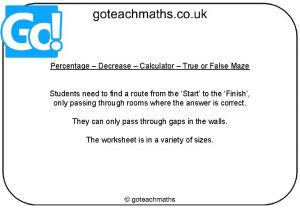
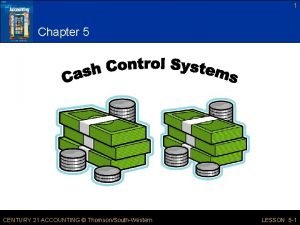
![Chars = [0] * 128 Chars = [0] * 128](https://slidetodoc.com/wp-content/uploads/2020/11/2253675_8306baa31f7a842cb260253fcf8641e4-300x225.jpg)
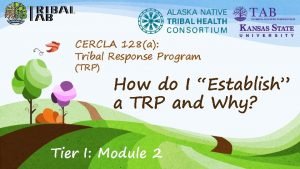
![Chars = [0] * 128 Chars = [0] * 128](https://slidetodoc.com/wp-content/uploads/2020/11/2552879_9e37114c6b84c82c1e68cd05d41a4f8b-300x225.jpg)

![Chars = [0] * 128 Chars = [0] * 128](https://slidetodoc.com/wp-content/uploads/2021/03/4280000_1c54efc359edbb9b02a7ca0198c495f3-300x225.jpg)


